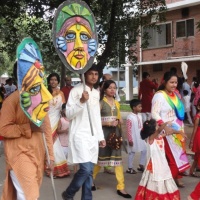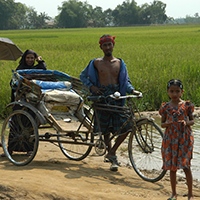Celebrating the Bengali New Year of 1423

Did you know that April 14 was the beginning of a new year? That’s right! The old one’s been over in no time and now we have the year 1423. We had described the origin of the holiday and its celebrations in an article last year and this year we will tell you what New Year means for the Bengalis and how it was celebrated in our schools. A celebration is above all about people who join it and start traditions… And this year, we too had our first-hand experience of the New Year in Bangladesh!
For everyone, New Year begins at dawn and everyone in Bangladesh celebrates it together. Girls and women put on a new, preferably red and white saree, arrange their hair with lovely flowers, decorate themselves with henna, earrings and bracelets and put on make-up. Families and friends gather in the morning, while neighbors and acquaintances visit each other the whole day, celebrating together under the open sky. The celebration includes a cultural program. For the whole year some of the Bengalis are looking forward to the traditional meals. In the hot day, they fully appreciate the taste of dried fish, shutki, and rice that’s been cooking all night, panta bhat.
The cultural program starts after the morning parade of masks. It always takes a few days to organize the program, rehearse children’s performances and build a stage. In the boarding school in Gopalgonj, south Bangladesh, not only the children had been rehearsing this year, but also their teachers who then sang and danced.
Redeeming from sins – a bit like Czech Easter
In the AHTSS boarding school in Hill Tracts, an area in south-east Bangladesh populated by many ethnic minorities, the celebrations were joyful. The people of the Marma tribe call the New Year holiday “Sangria” and uphold a special tradition similar to that maintained in Czechia at Easter (girls pour buckets of cold water on boys who have spanked them with pomlázka). In the case of Marmas, girls and boys pour water on one another – or rather drench themselves – and it’s not only for effect. They end up soaked to the skin: just watch the video.
You’d say that such enthusiasm in pouring water on others must have a special reason and you’d be right. It’s not malevolence! This Marma tradition symbolizes redeeming from one’s sins, freeing oneself from envy and injustice. To drench someone is to do them good, show them your love and forgive each another.
Dragons and kites
In AHTSS, dragon masks from New Year’s parades were replaced by flying paper dragons, kites; they held a kite-flying competition as part of the celebration. Flying a kite is mostly perceived as a boys’ thing in Bangladesh. However, all the contestants, students or teachers, were eager to make their own kites. Look at the photos from celebrations in GAPS, DAPS and AHTSS schools and you’ll find instructions on how to make a kite.
PS: The Bengali New Year is also an opportunity to make others happy, to give presents to your loved ones and also people in need. The day before New Year, we visited a mall and saw a kind Bengali taking five children in ragged clothes from the street to buy traditional red and white sarees. Their joy as they danced with the unexpected present was indescribable.



